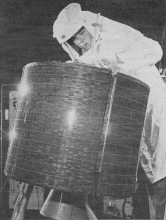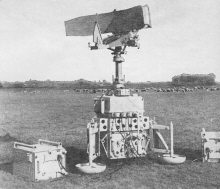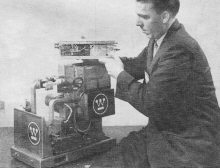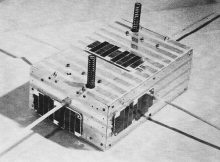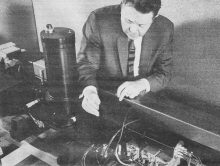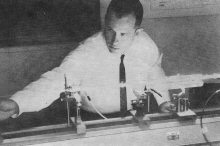Recent Developments in Electronics
|
|
Things were moving fast in the electronics development realm in the 1960s. Many relatively new technologies were undergoing rapid development due to a number of factors - high numbers of engineering and science students graduating from college, a huge demand by the commercial and consumer sectors for creature comfort products, the Cold War requirement for advanced weapons systems, and the advent of increasingly powerful computers for aiding the design process. Electronics World magazine ran a monthly column entitled "Recent Developments in Electronics" which reported on those activities. This July 1967 issue included the Early Bird communications satellite for supporting commercial telephone traffic and international television programming, a portable battlefield radar system, a radar transponder built with solid state devices rather than vacuum tubes, and the OSCAR III satellite designed and built by radio amateurs to enable Hams to participate in space communications. Recent Developments in Electronics
The world's first commercial communications satellite was launched successfully into a synchronous orbit at the beginning of April. The satellite, called "Early Bird," is shown here being prepared for space-simulation tests at Hughes Aircraft Co, which built the spacecraft for COMSAT. The satellite provides 240 two-way telephone channels between Europe and North America, or two-way television between the continents. It can also handle teletypewriter and facsimile along with phone conversations. Some 6000 solar cells power the electronic equipment in the new satellite. A battlefield radar system so sensitive that it will spot a moving person 9 miles away and a moving vehicle at 22 miles has been developed by a French subsidiary of ITT. The radar is a pulse system using Doppler effect for canceling stationary targets. Accuracy is within a quarter degree in azimuth and 65 feet in range. Equipment can be transported by a helicopter.
The small unit being held is the integrated-circuit PRADOR (Prf RAnging DOpler Radar), a feasibility model of a miniature space rendezvous radar transponder. The larger unit beneath is a transponder which is part of the all-solid-state radar system developed by Westinghouse in 1963. The integrated-circuit version is much smaller and has better ratings and performance. The miniature transponder was built to demonstrate the feasibility of using integrated electronic circuitry to achieve a huge reduction in size, weight, and complexity but with an increase in reliability. The unit uses 23 monolithic blocks, 13 multi-chip integrated circuits, 12 transistors, and 12 diodes. The system range is 500 nautical miles; it operates on X band.
Launched into orbit on March 9, this home-made radio amateur satellite was put into a 502-mile high, 103-minute orbit about the earth. The satellite, called "Oscar III," was designed to receive amateur 2-meter signals and to rebroadcast them on the same band. Record-shattering ham contacts have been made via the satellite across the Atlantic Ocean, between California and Argentina, between California and Hawaii, and between Alaska and the West Coast. Contacts have also been established with European hams in Switzerland, Germany, England, Czechoslovakia, and Sweden, The satellite was constructed by San Francisco Peninsula radio amateurs, directed by William I. Orr, W6SAI. The satellite was carried as a passenger into space aboard a research and development vehicle of the United States Air Force. The first terrain profiler using a laser has been successfully flight tested. The system consists of a c.w. gas laser altimeter, a high-resolution barometer sensor, and a strip or aerial mapping camera. Distance to the ground is measured continuously by comparing the difference in phase between the transmitted and received laser beams. The barometric sensor provides a reference to the aircraft's pressure altitude within one foot. By using the sensor, any recorded change in elevation represents changes in terrain rather than a change in aircraft altitude. At an altitude of 1000 feet, the profiler has an accuracy better than 1 foot; at 10,000 feet accuracy is within 2 feet. The new system has been designed and built by Litton Industries.
Two new techniques which produce a high-power, single-frequency laser beam capable of transmitting light signals efficiently have been developed by Sylvania scientists. The techniques, called the frequency-modulated laser and the super-mode laser, result in concentrating all of the energy of a high-power, multi-mode laser into a single discrete frequency in-stead of multiple frequencies that are close together. Briefly, the technique consists of phase-modulating a conventional laser beam by applying an electric field to a special crystalline optical modulator. The result is a signal that takes on the appearance of a frequency-modulated signal. This is then passed through a second optical phase modulator driven 1800 out of phase with the first one. The result is complete elimination of all modes except one.
Posted September 15, 2022 |
|

